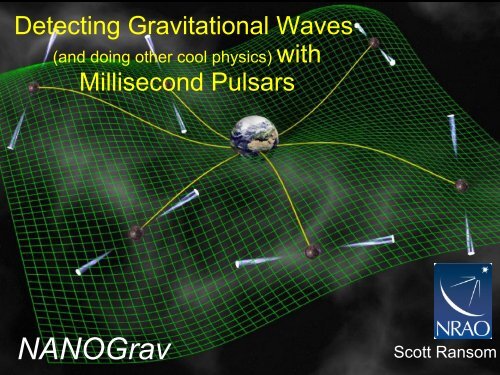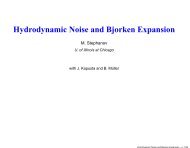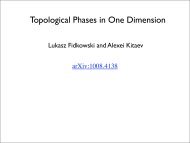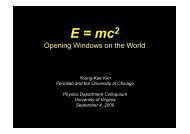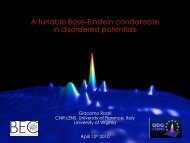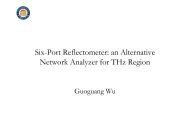Detecting Gravitational Waves (and doing other cool physics) with ...
Detecting Gravitational Waves (and doing other cool physics) with ...
Detecting Gravitational Waves (and doing other cool physics) with ...
Create successful ePaper yourself
Turn your PDF publications into a flip-book with our unique Google optimized e-Paper software.
<strong>Detecting</strong> <strong>Gravitational</strong> <strong>Waves</strong><br />
(<strong>and</strong> <strong>doing</strong> <strong>other</strong> <strong>cool</strong> <strong>physics</strong>) <strong>with</strong><br />
Millisecond Pulsars<br />
NANOGrav<br />
Scott Ransom
What’s a Pulsar ?<br />
●<br />
●<br />
Rotating Neutron Star!<br />
Size of city:<br />
– R ~ 10-20 km<br />
●<br />
Mass greater than Sun:<br />
– M ~ 1.4 M sun<br />
●<br />
Strong Magnetic Fields:<br />
– B ~ 10 8 -10 14 Gauss<br />
●<br />
●<br />
●<br />
Pulses are from a<br />
“lighthouse” type effect<br />
“Spin-down” power up to<br />
10,000 times more than<br />
the Sun's total output!<br />
Weak but broadb<strong>and</strong><br />
radio sources
High B<br />
Pulsar Flavors<br />
Young PSRs<br />
(high B, fast spin,<br />
very energetic)<br />
Young<br />
Normal PSRs<br />
(average B,<br />
slow spin)<br />
Millisecond PSRs<br />
(low B, very fast,<br />
very old, very stable<br />
spin, best for basic<br />
<strong>physics</strong> tests)<br />
Low B<br />
Old
Millisecond Pulsars are Very<br />
Precise Clocks<br />
PSR B1937+21<br />
At midnight on 5 Dec, 1998:<br />
P = 1.5578064688197945 ms<br />
+/- 0.0000000000000004 ms<br />
The last digit changes by about 1 per second!<br />
This extreme precision is what allows us to<br />
use pulsars as tools to do unique <strong>physics</strong>!
How are millisecond pulsars made?<br />
Binary system of supergiant<br />
And a normal star<br />
Supernova produces<br />
a neutron star<br />
Red Giant transfers<br />
matter to neutron star<br />
Millisecond Pulsar<br />
emerges <strong>with</strong> a white<br />
dwarf companion
Physics from Pulsars<br />
(see Bl<strong>and</strong>ford, 1992, PTRSLA, 341, 177 for a review)<br />
●<br />
●<br />
●<br />
●<br />
●<br />
●<br />
●<br />
●<br />
●<br />
●<br />
Newtonian <strong>and</strong> relativistic dynamics (e.g. binary pulsars)<br />
<strong>Gravitational</strong> wave <strong>physics</strong> (e.g. binaries, MSP timing)<br />
Physics at nuclear density (e.g. NS equations of state)<br />
Astro<strong>physics</strong> (e.g. stellar masses <strong>and</strong> evolution)<br />
Plasma <strong>physics</strong> (e.g. magnetospheres, pulsar eclipses)<br />
Fluid dynamics (e.g. supernovae collapse)<br />
Magnetohydrodynamics (MHD; e.g. pulsar winds)<br />
Relativistic electrodynamics (e.g. pulsar magnetospheres)<br />
Atomic <strong>physics</strong> (e.g. NS atmospheres)<br />
Solid state <strong>physics</strong> (e.g. NS crust properties)
Pulsar Timing<br />
●<br />
●<br />
●<br />
All of the science is<br />
from long-term timing<br />
Account for every<br />
rotation of the pulsar<br />
Fit the arrival times to<br />
a polynomial model after transforming the time:<br />
●<br />
●<br />
Accounts for pulsar spin, orbital, <strong>and</strong> astrometric<br />
parameters <strong>and</strong> Roemer, Einstein, <strong>and</strong> Shapiro<br />
delays in the Solar System <strong>and</strong> pulsar system<br />
Extraordinary precision for MSP timing
Pulsar Timing<br />
●<br />
●<br />
●<br />
All of the science is<br />
from long-term timing<br />
Account for every<br />
rotation of the pulsar<br />
Fit the arrival times to<br />
a polynomial model after transforming the time:<br />
●<br />
●<br />
Accounts for pulsar spin, orbital, <strong>and</strong> astrometric<br />
parameters <strong>and</strong> Roemer, Einstein, <strong>and</strong> Shapiro<br />
delays in the Solar System <strong>and</strong> pulsar system<br />
Extraordinary precision for MSP timing
Original time<br />
series<br />
Shift <strong>and</strong> add<br />
the pulses<br />
“Folding” Pulsar Data for Timing<br />
A strong “average” profile that<br />
can be cross correlated to<br />
get a Time-of-Arrival (TOA)
The science is in the<br />
residuals!:<br />
“Good” Timing Solution<br />
RMS precision ~ 10 -5 -10 -3 P<br />
Position error<br />
Uncorrected spin-down<br />
Proper motion
Timing Sensitivity<br />
Timing precision depends on:<br />
– Sensitivity (A/Tsys)<br />
– Pulse width (w)<br />
– Pulsar flux density (S)<br />
– Instrumentation<br />
Jenet & Demorest 2010, in prep.
Precision Timing Example<br />
• Astrometric Params<br />
– RA, DEC, μ, π<br />
• Spin Params<br />
– P spin<br />
, P spin<br />
• Keplerian Orbital Params<br />
– P orb<br />
, x, e, ω, T 0<br />
• Post-Keplerian Params<br />
– ω, γ, P orb<br />
, r , s<br />
~100 ns RMS<br />
timing residuals!<br />
Recent work (e.g. Verbiest et al 2009) shows<br />
this is sustainable over 5+ yrs for several MSPs<br />
van Straten et al., 2001<br />
Nature, 412, 158
Post-Keplerian Orbital Parameters<br />
General Relativity gives:<br />
(Advance of Periastron)<br />
(Grav redshift + time dilation)<br />
(Shapiro delay: “range” <strong>and</strong> “shape”)<br />
where: T ⊙<br />
≡ GM ⊙<br />
/c 3 = 4.925490947 μs,<br />
M = m 1<br />
+ m 2<br />
, <strong>and</strong> s ≡ sin(i)<br />
These are only functions of:<br />
- the (precisely!) known Keplerian orbital parameters P b<br />
, e, asin(i)<br />
- the mass of the pulsar m 1<br />
<strong>and</strong> the mass of the companion m 2
The Binary Pulsar: B1913+16<br />
●<br />
First binary pulsar discovered at Arecibo Observatory by<br />
Hulse <strong>and</strong> Taylor in 1974 (1975, ApJ, 195, L51)<br />
NS-NS Binary<br />
P psr<br />
= 59.03 ms<br />
P orb<br />
= 7.752 hrs<br />
a sin(i)/c = 2.342 lt-s<br />
e = 0.6171<br />
ω = 4.2 deg/yr<br />
M c<br />
= 1.3874(7) M ⊙<br />
M p<br />
= 1.4411(7) M ⊙
The Binary Pulsar: B1913+16<br />
Three post-Keplerian Observables: ω, γ, P orb<br />
Indirect detection of <strong>Gravitational</strong> Radiation!<br />
From Weisberg &<br />
Taylor, 2003
High-precision MSP Timing for<br />
<strong>Gravitational</strong> Wave Detection<br />
e.g. Detweiler, 1979<br />
Hellings & Downs, 1983<br />
●<br />
●<br />
The best MSPs<br />
(timing precisions<br />
between 50-200 ns<br />
RMS) can be used to<br />
search for nHz<br />
gravitational waves<br />
gw<br />
~1/yrs to 1/weeks<br />
● h ~ σ TOA<br />
/ T ~ 10 -15<br />
●<br />
●<br />
Sensitivity comparable<br />
<strong>and</strong> complementary to<br />
Adv. LIGO <strong>and</strong> LISA!<br />
Need best pulsars,<br />
instruments, <strong>and</strong><br />
telescopes!<br />
Credit: D. Backer
Pulsars <strong>and</strong> GW Basics<br />
Photon Path<br />
k µ<br />
Pulsar<br />
G-wave<br />
Earth<br />
Flat space metric <strong>with</strong> perturbations<br />
Frequency shifts occur along the<br />
photon path based on the G-wave<br />
Integral turns out to only be<br />
based on the metric at the<br />
Pulsar (then) <strong>and</strong> Earth (now)<br />
Integrate over the frequency shifts<br />
in time to get the timing residuals
So where do these GWs come from?<br />
Coalescing Super-Massive Black Holes<br />
•<br />
Basically all galaxies have them<br />
• Masses of 10 6 – 10 9 M ⊙<br />
•<br />
Galaxy mergers lead to BH mergers<br />
•<br />
When BHs <strong>with</strong>in 1pc, GWs are main energy loss<br />
• For total mass M/(1+z), distance d L<br />
, <strong>and</strong> SMBH<br />
orbital freq f, the induced timing residuals are:<br />
Potentially measurable <strong>with</strong> a single MSP!
So where do these GWs come from?<br />
3C66B<br />
At z = 0.02<br />
Orbital period 1.05 yrs<br />
Total mass 5.4x10 10<br />
(Sudou et al 2003)<br />
10 M ⊙<br />
Predicted timing<br />
residuals<br />
Ruled out by<br />
MSP observations<br />
Jenet et al. 2004, ApJ, 606, 799
Stochastic GW Backgrounds<br />
An ensemble of many individual GWs, from different<br />
directions <strong>and</strong> at different amplitudes <strong>and</strong> frequencies<br />
Characteristic strain spectrum is (basically) a power law:<br />
But see Sesana et al 2008<br />
The amplitude is the only unknown for each model<br />
e.g. Jenet et al. 2006, ApJ, 653, 1571
Best Single Pulsar Limits<br />
Power spectrum of induced timing residuals:<br />
Residuals (s)<br />
PSR B1855+09<br />
Kaspi, Taylor, Ryba. 1994, ApJ, 428, 713<br />
Demorest 2007,<br />
PhD Thesis
A Pulsar Timing Array (PTA)<br />
Timing residuals due to a GW have two components:<br />
“Pulsar components” are uncorrelated between MSPs<br />
“Earth components” are correlated between MSPs<br />
Signal in Residuals<br />
Clock errors:<br />
monopole<br />
Ephemeris errors:<br />
dipole<br />
GW signal:<br />
quadrupole<br />
Two-point correlation function<br />
Courtesy: G. Hobbs<br />
e.g. Hellings & Downs, 1983, ApJL, 265, 39;<br />
Jenet et al. 2005, ApJL, 625, 123
GW Detection <strong>with</strong> a Pulsar Timing Array<br />
●<br />
●<br />
Need good MSPs <strong>and</strong><br />
lots of time (patience)<br />
Significance scales<br />
linearly <strong>with</strong> the<br />
number of MSPs<br />
Canonical PTA:<br />
● Bi-weekly, multi-freq<br />
obs for 5-10 years<br />
● ~20-40 MSPs <strong>with</strong><br />
~100 ns timing RMS<br />
● This is not easy...
NANOGrav<br />
● About 22 members<br />
from North America<br />
● Observing ~20 MSPs<br />
● Using Arecibo <strong>and</strong> the<br />
GBT via 2 large<br />
projects (PI Paul<br />
Demorest)<br />
● 2 obs freqs at GBT, 2-<br />
3 at Arecibo per PSR<br />
● RMS residuals from<br />
~100ns to 1.5us<br />
● First 4 years of data<br />
limit h c<br />
(1yr -1 ) < 7x10 -15<br />
comparable to 20yrs<br />
of single MSP<br />
arXiv:0902.2968 <strong>and</strong> arXiv:0909.1058<br />
http://nanograv.org
NANOGrav improvement <strong>with</strong> time...<br />
Note complementarity<br />
<strong>with</strong> LIGO <strong>and</strong> LISA<br />
Courtesy P. Demorest
NANOGrav improvement <strong>with</strong> time...<br />
Courtesy P. Demorest<br />
Magenta <strong>and</strong> cyan curves show what happens if we<br />
improve our ability to time the pulsars by factors of ~3 <strong>and</strong> 10
So how do we improve?<br />
(in approx order of difficulty)<br />
●<br />
●<br />
●<br />
●<br />
●<br />
●<br />
●<br />
Patience...<br />
International PTA<br />
New instrumentation (more BW)<br />
Find more <strong>and</strong> better MSPs<br />
Better timing algorithms<br />
Improved underst<strong>and</strong>ing of the systematics.<br />
e.g. interstellar medium (ISM) effects<br />
Bigger telescopes (i.e. FAST <strong>and</strong> SKA)
International PTA
International PTA (5yr campaign)<br />
IPTA<br />
NANOGrav<br />
Courtesy J. Verbiest
GUPPI: A Pulsar “Dream Machine” for the GBT<br />
● 800 MHz BW coherent<br />
de-dispersion backend<br />
● 9x more BW ~ 3x<br />
more sensitive<br />
● High dynamic range<br />
(8-bit sampling) <strong>with</strong><br />
CASPER “iBob” <strong>with</strong> 2xADC<br />
full polarization<br />
boards (2Gsps each)<br />
● Large improvement in<br />
timing precision <strong>and</strong><br />
“control” of ISM effects<br />
● “CASPER” FPGAbased<br />
technology<br />
from Berkeley<br />
● Ready by end of 2009!<br />
e.g. Parsons et al 2006;<br />
http://seti.berkeley.edu/casper/<br />
CASPER “BEE2” compute<br />
board <strong>with</strong> 5 fast FPGAs
GUPPI: A Pulsar “Dream Machine” for the GBT<br />
● 800 MHz BW coherent<br />
de-dispersion backend<br />
● 9x more BW ~ 3x<br />
more sensitive<br />
● High dynamic range<br />
(8-bit sampling) <strong>with</strong><br />
CASPER “iBob” <strong>with</strong> 2xADC<br />
full polarization<br />
boards (2Gsps each)<br />
● Large improvement in<br />
timing precision <strong>and</strong><br />
“control” of ISM effects<br />
● “CASPER” FPGAbased<br />
technology<br />
from Berkeley<br />
● Ready by end of 2009!<br />
e.g. Parsons et al 2006;<br />
http://seti.berkeley.edu/casper/<br />
CASPER “BEE2” compute<br />
board <strong>with</strong> 5 fast FPGAs
Galactic ISM: electrons <strong>and</strong> radio waves...<br />
• Turbulent, Ionized ISM causes<br />
several time <strong>and</strong> radio<br />
frequency dependent effects:<br />
•Dispersion<br />
•Faraday Rotation<br />
•Multi-path propagation<br />
•Scintillation<br />
•Scattering<br />
• Some effects are removable,<br />
<strong>other</strong>s aren't (yet?)...<br />
• Much work ongoing in this area<br />
(see recent papers by<br />
Stinebring, Walker, Demorest,<br />
Cordes, Shannon, Rickett etc)<br />
From Cordes <strong>and</strong> Lazio 2001<br />
(NE2001)
Dispersion<br />
Lower frequency radio<br />
waves are delayed <strong>with</strong><br />
respect to higher frequency<br />
radio waves by the ionized<br />
interstellar medium<br />
t ∝ DM -2<br />
(DM = Dispersion Measure)<br />
Coherent Dedispersion<br />
exactly removes this effect
Pulse Broadening <strong>and</strong> Scintillation<br />
-4<br />
Multipath causes freq dependent pulse broadening <strong>and</strong> scintillation.
More MSPs<br />
●<br />
●<br />
●<br />
●<br />
Several large-scale searches for pulsars ongoing<br />
around the world: (GBT, Arecibo, Parkes, Effelsberg)<br />
MSPs are prime target: know ~1% of total in Galaxy<br />
Many bright <strong>and</strong> high-precision MSPs have yet to be<br />
discovered – some are very nearby<br />
Lots of “secondary” science
PSR J1903+0327 <strong>with</strong> Arecibo P-ALFA<br />
This thing is weird.<br />
- Fully recycled PSR<br />
- Highly eccentric orbit<br />
- Massive likely mainsequence<br />
star companion<br />
- Massive NS (1.7 Msun)<br />
- High precision timing<br />
despite being distant <strong>and</strong><br />
in Galactic plane<br />
Champion et al. 2008,<br />
Science, 320, 1309<br />
Bill Saxton, NRAO/AUI/NSF
PSR J1023+0038 is a “Missing Link” (w/ GBT)<br />
Previously (over last 10 yrs)<br />
detected in FIRST, optical<br />
images/spectra, <strong>and</strong> X-rays<br />
<strong>and</strong> identified as a strange<br />
CV or a quiescent LMXB!<br />
4.75 hr binary!<br />
Evidence for accretion!<br />
“Nasty” eclipses...<br />
Archibald et al. 2009,<br />
Science, 324, 1411
Very recently... Bright Fermi UnIDd Sources<br />
Bright Radio<br />
Binary MSPs!<br />
Ransom et al. in prep
●<br />
●<br />
●<br />
●<br />
●<br />
MSPs <strong>and</strong> GWs Summary<br />
Radio pulsars can potentially directly detect<br />
nHz frequency gravitational waves<br />
A detection <strong>with</strong> current facilities is possible<br />
(maybe even likely) in the next 5-15 years<br />
– Currently limits from single pulsars <strong>and</strong> initial PTAs<br />
are A ~ 10 -14 or slightly below (strain amplitude)<br />
– Arecibo buys us 5 yrs, 3x more obs buys us 3 yrs<br />
More <strong>and</strong> better MSPs for quicker detection<br />
With future very large radio telescopes (e.g.<br />
SKA) <strong>and</strong> many more MSPs, detailed study of<br />
nHz GWs is likely (A ~ 10 -17 )<br />
nanograv.org <strong>and</strong> white papers for more info
Arecibo <strong>and</strong> the IPTA
Recycled PSR Distances<br />
The known MSPs<br />
are local objects (<strong>and</strong><br />
are almost isotropically<br />
distributed on the sky.<br />
Gal<br />
Center


